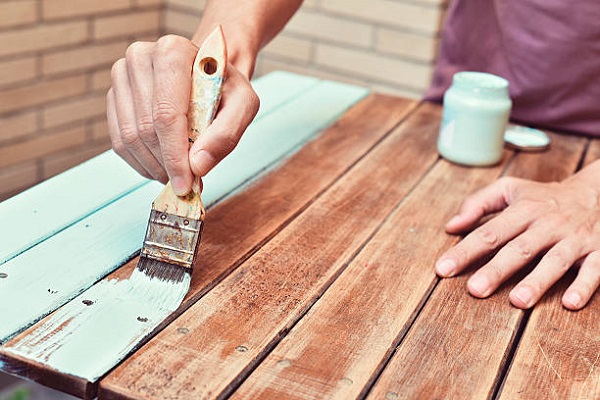
The Science of Stains: Understanding Different Types and Applications in Stain Work Solutions
Stain Work Solutions
Staining has become one of the most popular treatment options for wooden structures for home improvement and renovation projects. Rightfully so, since wood staining not only enhances the beauty of the wood by adding gradients and color but also protects your wood from wear and tear.
Specifically, if you have wood panels on your patio, wooden outdoor furniture, or fences and stairs, wood staining can really help when exposed to rain, sun, and winds. Here’s a guide to the science behind stains, exploring the different types available and their applications in stain work solutions.
What Is Wood Stain?
Stains are coloring agents that enhance the natural beauty of wood. Unlike paint, which forms a film on the surface, stains seep into the wood fibers, revealing the texture and grain of the wood. They also provide protection. A stain is translucent or semi-transparent and penetrates the surface of wood to add color.
Understanding Different Types of Stains and Applications in Stain Work Solutions
In the world of wood stains, there are at least seven different types of commercially available options for homeowners to choose from. Stains are usually grouped into two categories: oil-based and water-based. Each type has unique properties and uses, making them suitable for different projects and preferences.
1. Oil-Based Stains
Oil-based stain work solutions are a good choice for wood. They soak deep into the fibers, giving a rich color and strong protection. They work well outside because they resist water and last a long time. Outdoor projects like decks, fences, and furniture can benefit from this kind of stain.
Applications
Outdoor Decks
Oil-based stains are commonly used to stain work solutions outdoor decks due to their ability to withstand exposure to the elements. For example, staining a wooden deck with an oil-based stain can protect against moisture, UV rays, and foot traffic.
Fences
Oil-based stains are ideal for staining wooden fences, offering durability and weather resistance. Staining a cedar fence with an oil-based stain can enhance its natural beauty while providing long-lasting protection against rot and decay.
Outdoor Furniture
Staining outdoor furniture, such as wooden benches or patio tables, with oil-based stains can help preserve their appearance and integrity. Applying an oil-based stain to teak outdoor furniture can maintain its rich color and protect it from weather damage.
2. Water-Based Stains
Water-based stain work solutions are a good option for indoor projects like hardwood floors, furniture, and cabinets. They use water instead of solvents, which makes them dry quickly and easy to clean up. They don’t emit as many fumes as oil-based stains do, which makes them a safer choice for indoor use.
Applications
Hardwood Floors
Water-based stains are commonly used for staining hardwood floors indoors due to their low odor and quick drying times. For instance, staining oak hardwood floors with a water-based stain can achieve vibrant color while minimizing disruption to indoor spaces.
Furniture
Water-based stains are suitable for staining indoor furniture pieces such as tables, chairs, and cabinets. Staining pine furniture with a water-based stain can provide a smooth finish and allow for easy cleanup, making it ideal for interior woodworking projects.
Cabinets
Water-based stains can be used to stain kitchen or bathroom cabinets, offering versatility and ease of application. Staining maple cabinets with a water-based stain can create a contemporary look while providing protection against wear and tear.
3. Gel Stains
Gel stain work solutions have a thicker consistency than traditional liquid stains, which makes them easier to apply on vertical surfaces and helps achieve more consistent results on porous wood. They come in a range of colors and work well for indoor and outdoor projects.
Applications
Vertical Surfaces
Gel stains are well-suited for staining vertical surfaces such as doors, moldings, and cabinets due to their thick consistency. Staining a wooden door with a gel stain can result in even color distribution and minimize drips or runs.
Porous Woods
Gel stains are effective for staining porous woods such as pine or cherry, whereas traditional liquid stain work solutions may result in blotchy finishes. Staining a pine tabletop with a gel stain can achieve uniform coloration and highlight the wood’s natural grain patterns.
Detailed Woodwork
Gel stains can be used for intricate or detailed woodwork projects, such as ornate carvings or trim pieces. Staining decorative wooden trim with a gel stain can accentuate its design while providing a durable and long-lasting finish.
Conclusion
If you want to enhance the look of wood surfaces and keep them protected for a long time, consider using a stain. Choosing the right stain for your project can make a big difference in the final outcome. Stains can give your wood a beautiful and lasting finish that enhances its natural beauty. Knowing the science behind stains and how to apply them can help you achieve stunning results that stand the test of time.
Reach out to us for exceptional stain work solutions. We help you give your floors an ideal look so they can have a spectacular focal point boasting rich color, unparalleled durability, and long-lasting beauty. Give us a call today!
